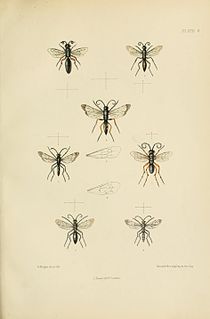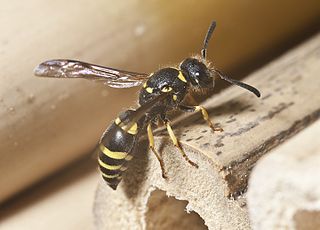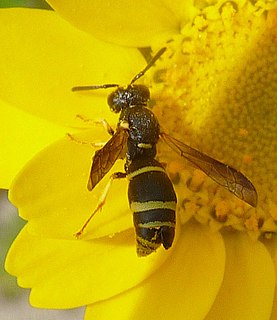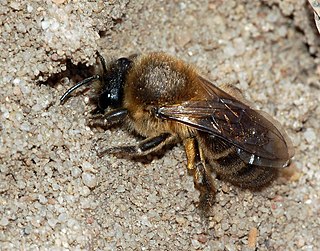
Philanthus triangulum, commonly known as the European beewolf, bee-killer wasp or the bee-eating philanthus, is a solitary wasp that lives in the Western Palearctic and Afrotropics. Although the adults of the species are herbivores, the species derives its name from the behaviour of the inseminated females, who hunt Western honey bees. The female places several of its paralysed prey together with an egg in a small underground chamber, to serve as food for the wasp larvae. All members of the genus Philanthus hunt various species of bees, but P. triangulum is apparently the only one that specialises in Western honey bees.

Commonly known as cuckoo wasps or emerald wasps, the hymenopteran family Chrysididae is a very large cosmopolitan group of parasitoid or kleptoparasitic wasps, often highly sculptured, with brilliant metallic colors created by structural coloration. They are most diverse in desert regions of the world, as they are typically associated with solitary bee and wasp species, which are also most diverse in such areas. Their brood parasitic lifestyle has led to the evolution of fascinating adaptations, including chemical mimicry of host odours by some species.

Ancistrocerus is a widely distributed genus of potter wasps present in many biogeographical regions of the world. They are nonpetiolate eumenine wasps with a transverse ridge at the bending summit of the first metasomal tergum and with a low and opaque propodeal lamella completely fused to the submarginal carina.

Osmia bicolor, the two-coloured mason-bee, is a Palearctic species of bee in the genus Osmia. It is outstanding amongst other megachilid bees in that it nests in empty snail shells.

The European potter wasp or European tube wasp is a species of potter wasp. As an imago (adult), the female collects as many as 20 caterpillars for each nest, which consists of a single cell. Her larval offspring then feed on these inside the nest, which is sealed with mud arranged by her. As adults, they eat nectar and aphid honeydew. Males cannot sting, and the sting of a female is not painful. They can be found on windows, foraging for nectar on flowers, or searching out small cracks or holes in which to nest.

Dipogon variegatus is a pompilid spider wasp in the subfamily Pepsinae from the Palearctic.

Agenioideus cinctellus is a spider wasp of the subfamily Pompilinae with a Palearctic distribution.

Chrysis ignita, also known as the ruby-tailed wasp, is a species of cuckoo wasps. Cuckoo wasps are kleptoparasites – they lay their eggs in the nests of other wasp species and their young consume the eggs or larva of the host wasp for sustenance. These wasps have a number of adaptions which have evolved to equip them for their life cycle. Chrysis ignita parasitize mason bees in particular. Ruby-tailed wasps have metallic, armored bodies, and can roll up into balls to protect themselves from harm when infiltrating the nests of host bees and wasps. Unlike most other Hymenopterans, cuckoo wasps cannot sting. Chrysis ignita is found across the European continent.

Crabro cribrarius, common name slender bodied digger wasp, is a species of wasp of the family Crabronidae.

Ancistrocerus nigricornis is a species of potter wasp.
Anoplius infuscatus is a species of spider wasp found mainly in Eurasia.

Argogorytes mystaceus is a species of solitary wasp in the family Crabronidae.

Chrysis viridula is a Western Palearctic species of cuckoo wasp, first described by Carl Linnaeus in 1761. Chrysis viridula is included in the genus Chrysis, and the family Chrysididae. It is a parasitoid of a number of species of eumenid wasp, mainly those in the genus Odynerus.

Symmorphus bifasciatus, the willow mason-wasp, is a species of potter wasp, from the subfamily Eumeninae of the social wasp family Vespidae which is widely distributed in the Palearctic region.

Odynerus spinipes, the spiny mason wasp, is a species of potter wasp from western Europe. It is the type species of the genus Odynerus, being first described by Carl Linnaeus in his landmark 1758 10th edition of Systema Naturae.

Cerceris rybyensis, the ornate tailed digger wasp, is a Palearctic species of solitary wasp from the family Crabronidae which specialised in hunting small to medium-sized mining bees. It is the type species of the genus Cerceris and was named as Sphex rybyensis by Carl Linnaeus in 1771.

Colletes cunicularius, the vernal colletes or spring mining bee, is a species of solitary bee from the family Colletidae which is widespread in the Palearctic from Britain to the Pacific Ocean which nests in areas of open, sandy soil.

Trichrysis cyanea is a species of cuckoo wasps, insects in the family Chrysididae.

Chrysis angustula is a species of cuckoo wasps, insects in the family Chrysididae.


















